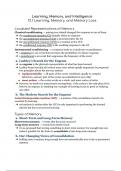Learning, Memory, and Intelligence
12.1 Learning, Memory, and Memory Loss
Localized Representations of Memory
Classical conditioning → pairing two stimuli changed the response to one of them
➔ the conditioned stimulus (CS) initially elicits no response
➔ the unconditioned stimulus (UCS) is presented after the CS
➔ the unconditioned response (UCR) is a reaction to the UCS
➔ the conditioned response (CR) is the resulting response to the CS
Instrumental conditioning → a response leads to a reinforcer or punishment
➔ a reinforcer is any event that increases the probability of a future response
➔ a punishment is an event that suppresses the frequency of the event
a. Lashley’s Search for the Engram
➔ an engram is the physical representation of what has been learned
➔ Lashley found out that all cortical areas were about equally important; he proposed
two principles about the nervous system:
● equipotentiality → all parts of the cortex contribute equally to complex
behaviors, and any part of the cortex can substitute for any other
● mass action → the cortex works as a whole, and more cortex is better
➔ however, he made two unnecessary assumptions: 1) the cortex is the only place fit to
look for an engram; 2) studying one example of learning is just as good as studying
any other
b. The Modern Search for the Engram
Lateral interpositus nucleus (LIP) → a nucleus of the cerebellum, found to be
essential for learning
➔ red nucleus (a section after the LIP) is only important in performing the learned
activity but does not prevent learning
Types of Memory
a. Short-Term and Long-Term Memory
Short-term memory → events that have just occurred
Long-term memory → events from further back
➔ it was proposed that storing something in short-term memory for enough time can
make it possible for the brain to consolidate it into long-term memory
b. Our Changing Views of Consolidation
➔ holding onto a memory long enough does not automatically turn it into a permanent
memory






